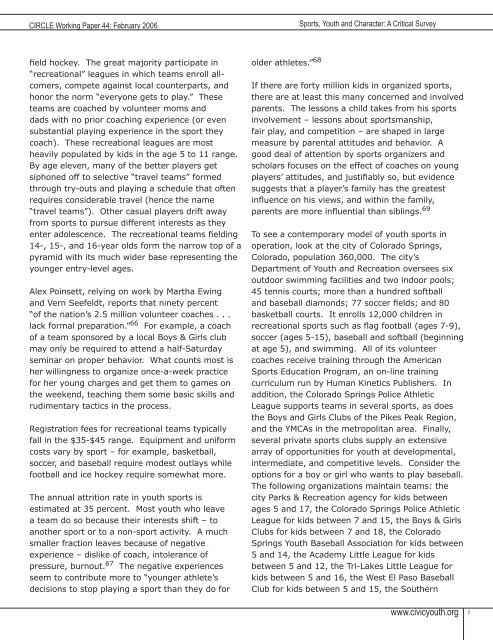The All-Sports Ministry of PA NJ & DE - Executive Summary Start-Up Budget & Prospectus
The All-Sports Ministry of PA NJ & DE - Executive Summary Start-Up Budget & Prospectus
The All-Sports Ministry of PA NJ & DE - Executive Summary Start-Up Budget & Prospectus
Create successful ePaper yourself
Turn your PDF publications into a flip-book with our unique Google optimized e-Paper software.
CIRCLE Working Paper 44: February 2006<br />
<strong>Sports</strong>, Youth and Character: A Critical Survey<br />
field hockey. <strong>The</strong> great majority participate in<br />
“recreational” leagues in which teams enroll allcomers,<br />
compete against local counterparts, and<br />
honor the norm “everyone gets to play.” <strong>The</strong>se<br />
teams are coached by volunteer moms and<br />
dads with no prior coaching experience (or even<br />
substantial playing experience in the sport they<br />
coach). <strong>The</strong>se recreational leagues are most<br />
heavily populated by kids in the age 5 to 11 range.<br />
By age eleven, many <strong>of</strong> the better players get<br />
siphoned <strong>of</strong>f to selective “travel teams” formed<br />
through try-outs and playing a schedule that <strong>of</strong>ten<br />
requires considerable travel (hence the name<br />
“travel teams”). Other casual players drift away<br />
from sports to pursue different interests as they<br />
enter adolescence. <strong>The</strong> recreational teams fielding<br />
14-, 15-, and 16-year olds form the narrow top <strong>of</strong> a<br />
pyramid with its much wider base representing the<br />
younger entry-level ages.<br />
Alex Poinsett, relying on work by Martha Ewing<br />
and Vern Seefeldt, reports that ninety percent<br />
“<strong>of</strong> the nation’s 2.5 million volunteer coaches . . .<br />
lack formal preparation.” 66 For example, a coach<br />
<strong>of</strong> a team sponsored by a local Boys & Girls club<br />
may only be required to attend a half-Saturday<br />
seminar on proper behavior. What counts most is<br />
her willingness to organize once-a-week practice<br />
for her young charges and get them to games on<br />
the weekend, teaching them some basic skills and<br />
rudimentary tactics in the process.<br />
Registration fees for recreational teams typically<br />
fall in the $35-$45 range. Equipment and uniform<br />
costs vary by sport – for example, basketball,<br />
soccer, and baseball require modest outlays while<br />
football and ice hockey require somewhat more.<br />
<strong>The</strong> annual attrition rate in youth sports is<br />
estimated at 35 percent. Most youth who leave<br />
a team do so because their interests shift – to<br />
another sport or to a non-sport activity. A much<br />
smaller fraction leaves because <strong>of</strong> negative<br />
experience – dislike <strong>of</strong> coach, intolerance <strong>of</strong><br />
pressure, burnout. 67 <strong>The</strong> negative experiences<br />
seem to contribute more to “younger athlete’s<br />
decisions to stop playing a sport than they do for<br />
older athletes.” 68<br />
If there are forty million kids in organized sports,<br />
there are at least this many concerned and involved<br />
parents. <strong>The</strong> lessons a child takes from his sports<br />
involvement – lessons about sportsmanship,<br />
fair play, and competition – are shaped in large<br />
measure by parental attitudes and behavior. A<br />
good deal <strong>of</strong> attention by sports organizers and<br />
scholars focuses on the effect <strong>of</strong> coaches on young<br />
players’ attitudes, and justifiably so, but evidence<br />
suggests that a player’s family has the greatest<br />
influence on his views, and within the family,<br />
parents are more influential than siblings. 69<br />
To see a contemporary model <strong>of</strong> youth sports in<br />
operation, look at the city <strong>of</strong> Colorado Springs,<br />
Colorado, population 360,000. <strong>The</strong> city’s<br />
Department <strong>of</strong> Youth and Recreation oversees six<br />
outdoor swimming facilities and two indoor pools;<br />
45 tennis courts; more than a hundred s<strong>of</strong>tball<br />
and baseball diamonds; 77 soccer fields; and 80<br />
basketball courts. It enrolls 12,000 children in<br />
recreational sports such as flag football (ages 7-9),<br />
soccer (ages 5-15), baseball and s<strong>of</strong>tball (beginning<br />
at age 5), and swimming. <strong>All</strong> <strong>of</strong> its volunteer<br />
coaches receive training through the American<br />
<strong>Sports</strong> Education Program, an on-line training<br />
curriculum run by Human Kinetics Publishers. In<br />
addition, the Colorado Springs Police Athletic<br />
League supports teams in several sports, as does<br />
the Boys and Girls Clubs <strong>of</strong> the Pikes Peak Region,<br />
and the YMCAs in the metropolitan area. Finally,<br />
several private sports clubs supply an extensive<br />
array <strong>of</strong> opportunities for youth at developmental,<br />
intermediate, and competitive levels. Consider the<br />
options for a boy or girl who wants to play baseball.<br />
<strong>The</strong> following organizations maintain teams: the<br />
city Parks & Recreation agency for kids between<br />
ages 5 and 17, the Colorado Springs Police Athletic<br />
League for kids between 7 and 15, the Boys & Girls<br />
Clubs for kids between 7 and 18, the Colorado<br />
Springs Youth Baseball Association for kids between<br />
5 and 14, the Academy Little League for kids<br />
between 5 and 12, the Tri-Lakes Little League for<br />
kids between 5 and 16, the West El Paso Baseball<br />
Club for kids between 5 and 15, the Southern<br />
www.civicyouth.org 7

















